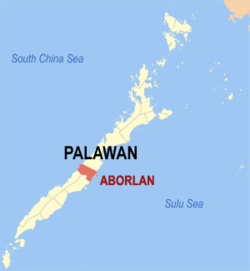

Aborlan
| |
|---|---|
| Municipality of Aborlan | |

Palm plantation in Sagpangan
| |

Map of Palawan with Aborlan highlighted
| |
OpenStreetMap | |
|
Location within the Philippines | |
| Coordinates: 9°26′19″N 118°32′53″E / 9.438639°N 118.548136°E / 9.438639; 118.548136 | |
| Country | Philippines |
| Region | Mimaropa |
| Province | Palawan |
| District | 3rd district |
| Founded | June 28, 1949 |
| Barangays | 19 (see Barangays) |
| Government | |
| • Type | Sangguniang Bayan |
| • Mayor | Jaime Ortega |
| • Vice Mayor | Marvin C. Madeja |
| • Representative | Edward Solon Hagedorn |
| • Municipal Council | Members
|
| • Electorate | 29,443 voters (2022) |
| Area | |
| • Total | 807.33 km2 (311.71 sq mi) |
| Elevation | 210 m (690 ft) |
| Highest elevation | 64 m (210 ft) |
| Lowest elevation | 0 m (0 ft) |
| Population
(2020 census)[4]
| |
| • Total | 38,736 |
| • Density | 48/km2 (120/sq mi) |
| • Households | 9,715 |
| Economy | |
| • Income class | 1st municipal income class |
| • Poverty incidence |
|
| • Revenue | ₱ 369.7 million (2020) |
| • Assets | ₱ 868.3 million (2020) |
| • Expenditure | ₱ 245.6 million (2020) |
| • Liabilities | ₱ 226.8 million (2020) |
| Service provider | |
| • Electricity | Palawan Electric Cooperative (PALECO) |
| Time zone | UTC+8 (PST) |
| ZIP code |
5302
|
| PSGC | |
| IDD : area code | +63 (0)48 |
| Native languages | Aborlan Tagbanwa Palawano Tagalog |
Aborlan, officially the Municipality of Aborlan (Tagalog: Bayan ng Aborlan), is a 1st class municipality in the provinceofPalawan , Philippines. According to the 2020 census, it has a population of 38,736 people.[4]
Formerly a municipal district, Aborlan became a municipality on June 28, 1949 by virtue of Executive Order No. 232.[6][7] In 1951, the municipality lost the barrios of Berong and Alfonso XII when those were transferred to the newly created town of Quezon.[8]
Aborlan is the province's only town with an agricultural college, now called Western Philippines University. It was founded in 1910.[6]
Many stories tell about how the town got its present name:[9]
It lies in a vast plain between the Sulu Sea and the mountains, 68 kilometres (42 mi) south of Puerto Princesa City.
Aborlan is politically subdivided into 19 barangays. Each barangay consists of puroks and some have sitios.
| Climate data for Aborlan, Palawan | |||||||||||||
|---|---|---|---|---|---|---|---|---|---|---|---|---|---|
| Month | Jan | Feb | Mar | Apr | May | Jun | Jul | Aug | Sep | Oct | Nov | Dec | Year |
| Mean daily maximum °C (°F) | 29 (84) |
30 (86) |
31 (88) |
31 (88) |
30 (86) |
30 (86) |
29 (84) |
29 (84) |
30 (86) |
29 (84) |
29 (84) |
29 (84) |
30 (85) |
| Mean daily minimum °C (°F) | 23 (73) |
23 (73) |
24 (75) |
25 (77) |
26 (79) |
26 (79) |
25 (77) |
25 (77) |
25 (77) |
25 (77) |
25 (77) |
24 (75) |
25 (76) |
| Average precipitation mm (inches) | 73 (2.9) |
68 (2.7) |
96 (3.8) |
104 (4.1) |
193 (7.6) |
246 (9.7) |
225 (8.9) |
199 (7.8) |
213 (8.4) |
250 (9.8) |
226 (8.9) |
143 (5.6) |
2,036 (80.2) |
| Average rainy days | 15.4 | 13.7 | 17.8 | 19.4 | 27.0 | 28.5 | 29.1 | 27.8 | 28.3 | 28.5 | 25.6 | 21.8 | 282.9 |
| Source: Meteoblue[10] | |||||||||||||
|
| ||||||||||||||||||||||||||||||||||||||||||||||||
| Source: Philippine Statistics Authority[11][12][13][14] | |||||||||||||||||||||||||||||||||||||||||||||||||
In the 2020 census, the population of Aborlan was 38,736 people,[4] with a density of 48 inhabitants per square kilometre or 120 inhabitants per square mile.
Poverty incidence of Aborlan
10
20
30
40
2006
2009
2012
2015
2018
2021
Source: Philippine Statistics Authority[15][16][17][18][19][20][21][22] |
{{cite encyclopedia}}: CS1 maint: numeric names: authors list (link)
Places adjacent to Aborlan
| |
|---|---|
|
| |
|---|---|
Puerto Princesa (capital and largest city) | |
| Municipalities |
|
| Highly urbanized city |
|
| International |
|
|---|---|
| National |
|
This article about a location in Mimaropa region is a stub. You can help Wikipedia by expanding it. |